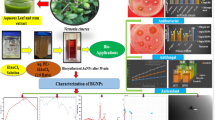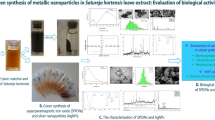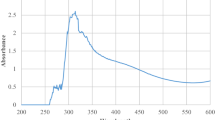Abstract
Biomediated synthesis of gold nanoparticles (AuNPs) using plant extract is a favorable alternative to traditional physicochemical based methods. Biological synthesis assists in the generation of stable and biocompatible nanoparticles (NPs). The aim of the present work was to fabricate AuNPs using Pongamia pinnata leave extract. The synthesized AuNPs were characterized by various analytical techniques such as UV–visible spectroscopy, TEM, EDX, and XRD. Absorption spectra showed SPR peaks in the range of 520–540 nm signifying the formation of AuNPs stabilized by P. pinnata extract. The average size of NPs was found in the range 10–25 nm as obtained from TEM analysis. Moreover, the synthesized NPs showed antifungal activity. The antifungal activities of AuNPs were tested against oomycetes SR1 and BP1120. The MIC80 value was observed at the concentrations 1.6 and 0.8 mg/mL of AuNPs in SR1 and BP1120 fungus, respectively. The study revealed an efficient, eco-friendly and simple method for synthesis of stable AuNPs using green synthetic approach.





Similar content being viewed by others
References
C. T. Laurencin, S. G. Kumbar, and S. P. Nukavarapu (2009). Wiley Interdiscip. Rev. Nanomed. Nanobiotechnol.1, 6.
H. Barabadi, F. Kobarfard, and H. Vahidi (2018). Iran J. Pharm. Res.17, 87.
H. Barabadi (2017). Cell. Mol. Biol.63, 3.
S. Ahmed, M. Ahmad, B. L. Swami, and S. Ikram (2016). J. Adv. Res.7, 17.
Q. Abbas, M. Saleem, A. R. Phull, M. Rafiq, M. Hassan, K.-H. Lee, and S.-Y. Seo (2017). Iran J. Pharm. Res.16, 760.
R. Dobrucka (2017). Iran J. Pharm. Res.16, 753.
N. Karimi, A. Chardoli, and A. Fattahi (2017). Iran J. Pharm. Res.16, 1167.
M. M. Or Rashid, M. S. Islam, M. A. Haque, M. A. Rahman, M. T. Hossain, and M. A. Hamid (2016). Iran J. Pharm. Res.15, 591.
S. Salari, S. Esmaeilzadeh Bahabadi, A. Samzadeh-Kermani, and F. Yousefzaei (2019). Iran J. Pharm. Res.18, 430.
T. Ramezani, M. Nabiuni, J. Baharara, K. Parivar, and F. Namvar (2019). Iran J. Pharm. Res.18, 222.
M. Maham and R. Karami-Osboo (2017). Iran J. Pharm. Res.16, 462.
Z. Rezvani Amin, Z. Khashyarmanesh, B. S. Fazly Bazzaz, and Z. Sabeti Noghabi (2019). Iran J. Pharm. Res.18, 210.
H. Barabadi, B. Tajani, M. Moradi, K. Damavandi Kamali, R. Meena, S. Honary, M. A. Mahjoub, and M. Saravanan (2019). J. Clust. Sci.. https://doi.org/10.1007/s10876-019-01554.
S. Honary, H. Barabadi, P. Ebrahimi, F. Naghibi, and A. Alizadeh (2015). J. Nano Res.30, 106.
H. Barabadi and S. Honary (2016). Pharm. Biomed. Res.2, 1.
M. Saravanan, S. Arokiyaraj, T. Lakshmi, and A. Pugazhendhi (2018). Microb. Pathog.117, 68.
S. A. Dahoumane, M. Mechouet, K. Wijesekera, C. D. M. Filipe, C. Sicard, D. A. Bazylinski, and C. Jeffryes (2017). Green Chem.19, 552.
M. Faraday (1857). Lond. Edinb. Dubl. Philos. Mag.14, 512.
A. Nel, T. **a, L. Madler, and N. Li (2006). Science311, 622.
R. A. Sperling, P. Rivera Gil, F. Zhang, M. Zanella, and W. J. Parak (2008). Chem. Soc. Rev.37, 1896.
M. Ovais, A. T. Khalil, A. Raza, M. A. Khan, I. Ahmad, N. U. Islam, M. Saravanan, M. F. Ubaid, M. Ali, and Z. K. Shinwari (2016). Nanomedicine (Lond.)11, 3157.
R. K. Singh, G. Nath, S. B. Acharya, and R. K. Goel (1997). Indian J. Exp. Biol.35, 831.
R. Sankaranarayanan and J. Ferlay (2006). Best. Pract. Res. Clin. Obstet. Gynaecol.20, 207.
N. Munoz, F. X. Bosch, S. de Sanjose, R. Herrero, X. Castellsague, K. V. Shah, P. J. Snijders, and C. J. Meijer (2003). N. Engl. J. Med.348, 518.
R. K. Singh, V. K. Joshi, R. K. Goel, S. S. Gambhir, and S. B. Acharya (1996). Indian J. Exp. Biol.34, 1204.
T. S. Ramakrishnan and C. K. Sowmini (1955). Indian Phytopath.7, 152.
C. Ushamalini, P. Nakkeeran, and T. Marimuthu (2008). Arch. Phytopathol. Plant Protect.41, 79.
N. Radhakrishnan and R. Balasubramanian (2009). Crop Protect.28, 974.
C. Kole, P. Kole, K. M. Randunu, P. Choudhary, R. Podila, P. C. Ke, A. M. Rao, and R. K. Marcus (2013). BMC Biotechnol.13, 37.
F. Ghazizadeh, S. Ghaffari, S. F. Mirshojaei, M. Mazidi, and S. Azarmi (2018). Iran J. Pharm. Res.17, 1209.
H. Sobhani, P. Tarighi, S. N. Ostad, A. Shafaati, N. Nafissi-Varcheh, and R. Aboofazeli (2018). Iran J. Pharm. Res.17, 830.
G. M. L. Consoli, G. Granata, R. Picciotto, A. R. Blanco, C. Geraci, A. Marino, and A. Nostro (2018). Medchemcomm9, 160.
H. E. Karahan, L. Wei, K. Goh, Z. Liu, O. Birer, F. Dehghani, C. Xu, J. Wei, and Y. Chen (2016). Nanoscale8, 17181.
W. Haiss, N. T. Thanh, J. Aveyard, and D. G. Fernig (2007). Anal. Chem.79, 4215.
C. Karuppiah, S. Palanisamy, S.-M. Chen, R. Emmanuel, K. Muthupandi, and P. Prakash (2015). RSC Adv.5, 16284.
G. Frens (1973). Nat. Phys. Sci.241, 20.
S. Park, H. Chibli, J. Wong, and J. L. Nadeau (2011). Nanotechnology22, 185101.
S. Nath, C. Kaittanis, A. Tinkham, and J. M. Perez (2008). Anal. Chem.80, 1033.
S. Ray, R. Mohan, J. K. Singh, M. K. Samantaray, M. M. Shaikh, D. Panda, and P. Ghosh (2007). J. Am. Chem. Soc.129, 15042.
R. Langer and D. A. Tirrell (2004). Nature428, 487.
T. M. Allen and P. R. Cullis (2004). Science303, 1818.
Acknowledgements
The authors are grateful to AIRF, JNU for analytical characterization. EP is grateful to DST-SERB for fellowship under National Postdoctoral Scheme (Grant Number: PDF/2017/0024). We thank our colleague Dr. Usha Singh and other colleagues who provided insight and expertise that greatly assisted the research, this study was supported by grants from the project Boron capture therapy in cancer diagnosis.
Author information
Authors and Affiliations
Corresponding authors
Additional information
Publisher's Note
Springer Nature remains neutral with regard to jurisdictional claims in published maps and institutional affiliations.
Rights and permissions
About this article
Cite this article
Khatua, A., Priyadarshini, E., Rajamani, P. et al. Phytosynthesis, Characterization and Fungicidal Potential of Emerging Gold Nanoparticles Using Pongamia pinnata Leave Extract: A Novel Approach in Nanoparticle Synthesis. J Clust Sci 31, 125–131 (2020). https://doi.org/10.1007/s10876-019-01624-6
Received:
Published:
Issue Date:
DOI: https://doi.org/10.1007/s10876-019-01624-6




